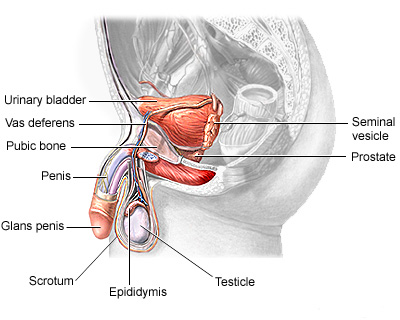Spermatoceles (spermatic cyst)
Contents
What are the symptoms of spermatoceles?
How are spermatoceles diagnosed?
How are spermatoceles treated?
What can be expected after surgical treatment?

The male reproductive structures include the penis, the scrotum, the seminal vesicles and the prostate.
What is a spermatoceles?
Spermatocele, also known as a spermatic cyst, are typically painless, noncancerous (benign) fluid filled cysts that are outpocketing of fluid from the epididymis. They usually sit near the top and/or behind the testicle, but appear separate from the testis. Spermatoceles are typically smooth and they are usually filled with a whitish, cloudy fluid and usually contain sperm. Over time, spermatoceles may remain stable in size or they may grow. If in fact the size becomes bothersome, or results in pain, then there are several treatment options to rectify the problem. Spermatoceles are generally no more than a nuisance rather than a serious medical condition.
What can cause spermatoceles?
The precise cause of spermatoceles is not known. While spermatoceles may form as a result of trauma or inflammation, these conditions are certainly not required for spermatocele formation. Others suggest that blockage of the efferent ducts and epididymis result in spermatocele formation. Additionally, in utero exposure to diethylstilbestrol (DES), a synthetic form of estrogen, has also been suggested as a possible cause.
How common are spermatoceles?
The precise incidence of spermatoceles is unknown, but an estimated 30 percent of all men have small spermatoceles with larger sized spermatococeles being much less common.. Incidence increases with age, with peak rates for the diagnosis of spermatoceles occurring in men in their forties and fifties. No racial or ethnic predispositions to spermatocele formation are known.
What are the symptoms of spermatoceles?
Men with spermatoceles usually have no symptoms. However, when associated symptoms are present, they may include scrotal heaviness and/or dull discomfort but usually not sharp pain.
How are spermatoceles diagnosed?
Spermatoceles are typically discovered through a man's self-examination of his testicles or at the time of an evaluation by a physician. Light can be shined through a spermatocele (transillumination), indicating that the mass is not a solid tumor but more likely a benign cyst.Ultrasound examination remains a very reliable means of evaluation and is a relatively quick, noninvasive and inexpensive test.
How are spermatoceles treated?
Since spermatoceles generally do not cause discomfort and often go unnoticed by patients, they RARELY require treatment. The standard treatment for spermatoceles without pain is observation. Nevertheless, some affected individuals do experience significant associated symptoms, such as bothersome size or pain. When intervention is indicated, the available treatment options include:
Medical therapy: Oral analgesics or anti-inflammatory agents may be used to relieve pain associated with symptomatic spermatoceles. No other type of medical therapy is specifically indicated for the treatment of spermatoceles.
Minimally invasive therapies: Aspiration and sclerotherapy are two less commonly utilized approaches to treat spermatoceles. Aspiration involves puncture of the spermatocele with a needle and withdrawal of its contents into a syringe. Sclerotherapy is performed with subsequent injection of an irritating agent directly into the spermatocele sac to cause it to heal or scar closed, removing the spermatocele space which theoretically decreases the odds of fluid reaccumulation. Although several reports describe the effectiveness and tolerability of these treatment options, they are generally not recommended. Spermatocele recurrence is a common complication with both approaches, and chemical epididymitis and pain are common complications with sclerotherapy. Furthermore, aspiration and sclerotherapy have limited applicability in men of reproductive age, due to the significant risk of epididymal damage potentially leading to obstruction and resultant subfertility.
Surgical therapy: Spermatocelectomy is the standard treatment of symptomatic spermatoceles and involves surgical removal of the spermatocele from the adjoining epididymal tissue. The overall goal of surgical therapy is removal of the spermatocele with preservation of the continuity of the male reproductive tract. This an outpatient procedure is usually performed under local anesthesia with sedation or general anesthesia and usually takes less than one hour to perform. Sometimes, the epididymis is removed as well when a spermatocelectomy is performed.
What can be expected after surgical treatment?
Patients are generally discharged home with a pressure dressing consisting of an athletic supporter filled with fluffy gauze. Ice packs are applied for two to three days to minimize swelling. Oral pain medications are generally used for one to two days postoperatively. Patients usually may shower at 48 hours after surgery, and a follow-up visit is scheduled for one to three weeks after the procedure. Patients usually wear a scrotal support for 7-14 days after the procedure. Scrotal swelling is usual and will typically last from 2 -21 days.
Potential complications of spermatocelectomy are not common but include fever, infection, bleeding (scrotal hematoma), recurrence and persistent pain. Recurrence of a spermatocele occurs in approximately 10-25% of cases. Furthermore, inadvertent epididymal obstruction may result, which can lead to subfertility or infertility. Therefore, intervention should be avoided in men who still desire children.
Source: http://www.urologyhealth.org/urology/index.cfm?article=117

